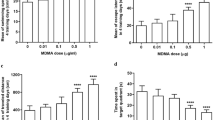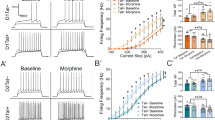Abstract
Heroin is a highly addictive drug that causes axonal damage. Here, manganese-enhanced magnetic resonance imaging (MEMRI) was used to dynamically monitor axonal transport at different stages of heroin addiction. Rat models of heroin addiction (HA) and prolonged heroin addiction (PHA) were established by injecting rats with heroin at different stages. Heroin-induced learning and memory deficits were evaluated in the Morris water maze (MWM), and MEMRI was used to dynamically evaluate axonal transport in the olfactory pathway. The expression of proteins related to axonal structure and function was also assessed by Western blotting. Transmission electron microscopy (TEM) was used to observe ultrastructural changes, and protein levels of neurofilament heavy chain (NF-H) were analyzed by immunofluorescence staining. HA rats, especially PHA rats, exhibited worse spatial learning and memory than control rats. Compared with HA rats and control rats, PHA rats exhibited significantly longer escape latencies, significantly fewer platform-location crossings, and significantly more time in the target quadrant during the MWM test. Mn2+ transport was accelerated in HA rats. PHA rats exhibited severely reduced Mn2+ transport, and the axonal transport rate (ATR) was significantly lower in these rats than in control rats (P < 0.001). The levels of cytoplasmic dynein and kinesin-1 were significantly decreased in the PHA group than in the control group (P < 0.001); additionally, the levels of energy-related proteins, including cytochrome c oxidase (COX) IV and ATP synthase subunit beta (ATPB), were lower in the PHA group (P < 0.001). The brains of heroin-exposed rats displayed an abnormal ultrastructure, with neuronal apoptosis and mitochondrial dysfunction. Heroin exposure decreased the expression of NF-H, as indicated by significantly reduced staining intensities in tissues from HA and PHA rats (P < 0.05). MEMRI detected axonal transport dysfunction caused by long-term repeated exposure to heroin. The main causes of axonal transport impairment may be decreases in the levels of motor proteins and mitochondrial dysfunction. This study shows that MEMRI is a potential tool for visualizing axonal transport in individuals with drug addictions, providing a new way to evaluate addictive encephalopathy.











Similar content being viewed by others
Data and Materials Availability
The datasets generated and analyzed in the current study are available from the corresponding author on request.
References
Aimino MA, Coker CR, Silberman Y (2018) Acute ethanol modulation of neurocircuit function in the nucleus of the tractus solitarius [J]. Brain Res Bull 138:5–11. https://doi.org/10.1016/j.brainresbull.2017.07.019
Akbari M, Kirkwood TBL, Bohr VA (2019) Mitochondria in the signaling pathways that control longevity and health span [J]. Ageing Res Rev 54:100940. https://doi.org/10.1016/j.arr.2019.100940
Anthony IC, Norrby KE, Dingwall T et al (2010) Predisposition to accelerated Alzheimer-related changes in the brains of human immunodeficiency virus negative opiate abusers [J]. Brain 133(Pt 12):3685–3698. https://doi.org/10.1093/brain/awq263
Aschrafi A, Kar AN, Natera-Naranjo O et al (2012) MicroRNA-338 regulates the axonal expression of multiple nuclear-encoded mitochondrial mRNAs encoding subunits of the oxidative phosphorylation machinery [J]. Cell Mol Life Sci 69(23):4017–4027. https://doi.org/10.1007/s00018-012-1064-8
Aschrafi A, Natera-Naranjo O, Gioio AE et al (2010) Regulation of axonal trafficking of cytochrome c oxidase IV mRNA [J]. Mol Cell Neurosci 43(4):422–430. https://doi.org/10.1016/j.mcn.2010.01.009
Barnett MH, Miller LA, Reddel SW et al (2001) Reversible delayed leukoencephalopathy following intravenous heroin overdose [J]. J Clin Neurosci 8(2):165–167. https://doi.org/10.1054/jocn.2000.0769
Barnhart CD, Yang D, Lein PJ (2015) Using the Morris water maze to assess spatial learning and memory in weanling mice [J]. PLoS One 10(4):e0124521. https://doi.org/10.1371/journal.pone.0124521
Bearer EL, Falzone TL, Zhang X et al (2007) Role of neuronal activity and kinesin on tract tracing by manganese-enhanced MRI (MEMRI) [J]. Neuroimage 37 Suppl 1(Suppl 1):S37–46. https://doi.org/10.1016/j.neuroimage.2007.04.053
Bora E, Yücel M, Fornito A et al (2012) White matter microstructure in opiate addiction [J]. Addict Biol 17(1):141–148. https://doi.org/10.1111/j.1369-1600.2010.00266.x
Büttner A, Mall G, Penning R et al (2000) The neuropathology of heroin abuse [J]. Forensic Sci Int 113(1–3):435–442. https://doi.org/10.1016/s0379-0738(00)00204-8
Büttner A, Rohrmoser K, Mall G et al (2006) Widespread axonal damage in the brain of drug abusers as evidenced by accumulation of beta-amyloid precursor protein (beta-APP): an immunohistochemical investigation [J]. Addiction 101(9):1339–1346. https://doi.org/10.1111/j.1360-0443.2006.01505.x
Cadet JL, Bisagno V, Milroy CM (2014) Neuropathology of substance use disorders [J]. Acta Neuropathol 127(1):91–107. https://doi.org/10.1007/s00401-013-1221-7
Dan X, Wechter N, Gray S et al (2021) Olfactory dysfunction in aging and neurodegenerative diseases [J]. Ageing Res Rev 70:101416. https://doi.org/10.1016/j.arr.2021.101416
Deng W, Faiq MA, Liu C et al (2019) Applications of manganese-enhanced magnetic resonance imaging in ophthalmology and visual neuroscience [J]. Front Neural Circuits 13:35. https://doi.org/10.3389/fncir.2019.00035
Fitzpatrick RE, Rubenis AJ, Lubman DI et al (2020) Cognitive deficits in methamphetamine addiction: independent contributions of dependence and intelligence [J]. Drug Alcohol Depend 209:107891. https://doi.org/10.1016/j.drugalcdep.2020.107891
Gibbs KL, Greensmith L, Schiavo G (2015) Regulation of axonal transport by protein kinases [J]. Trends Biochem Sci 40(10):597–610. https://doi.org/10.1016/j.tibs.2015.08.003
Gruber SA, Silveri MM, Yurgelun-Todd DA (2007) Neuropsychological consequences of opiate use [J]. Neuropsychol Rev 17(3):299–315. https://doi.org/10.1007/s11065-007-9041-y
Guo T, Noble W, Hanger DP (2017) Roles of tau protein in health and disease [J]. Acta Neuropathol 133(5):665–704. https://doi.org/10.1007/s00401-017-1707-9
Guo W, Stoklund Dittlau K, Van Den Bosch L (2020) Axonal transport defects and neurodegeneration: molecular mechanisms and therapeutic implications [J]. Semin Cell Dev Biol 99:133–150. https://doi.org/10.1016/j.semcdb.2019.07.010
Karle KN, Möckel D, Reid E et al (2012) Axonal transport deficit in a KIF5A( -/- ) mouse model [J]. Neurogenetics 13(2):169–179. https://doi.org/10.1007/s10048-012-0324-y
Kashyap S, Majeed G, Bowen I et al (2020) Toxic leukoencephalopathy due to inhalational heroin abuse [J]. Ann Indian Acad Neurol 23(4):542–544. https://doi.org/10.4103/aian.AIAN_446_18
Klein G, Juni A, Arout CA et al (2008) Acute and chronic heroin dependence in mice: contribution of opioid and excitatory amino acid receptors [J]. Eur J Pharmacol 586(1–3):179–188. https://doi.org/10.1016/j.ejphar.2008.02.035
Kreek MJ, Levran O, Reed B et al (2012) Opiate addiction and cocaine addiction: underlying molecular neurobiology and genetics [J]. J Clin Invest 122(10):3387–3393. https://doi.org/10.1172/jci60390
Kumar N, Bhalla MC, Frey JA et al (2015) Intraparenchymal hemorrhage after heroin use [J]. Am J Emerg Med 33(8):1109.e1103–1104. https://doi.org/10.1016/j.ajem.2015.01.007
Lee Y, Lee BH, Yip W et al (2020) Neurofilament proteins as prognostic biomarkers in neurological disorders [J]. Curr Pharm Des 25(43):4560–4569. https://doi.org/10.2174/1381612825666191210154535
Leppert W (2015) Emerging therapies for patients with symptoms of opioid-induced bowel dysfunction [J]. Drug Des Devel Ther 9:2215–2231. https://doi.org/10.2147/dddt.S32684
Li Y, Xia B, Li R et al (2017a) Changes in expression of dopamine, its receptor, and transporter in nucleus accumbens of heroin-addicted rats with brain-derived neurotrophic factor (BDNF) overexpression [J]. Med Sci Monit 23:2805–2815. https://doi.org/10.12659/msm.904670
Li Y, Xia B, Li R et al (2017b) Expression of brain-derived neurotrophic factors, neurotrophin-3, and neurotrophin-4 in the nucleus accumbens during heroin dependency and withdrawal [J]. Neuroreport 28(11):654–660. https://doi.org/10.1097/wnr.0000000000000810
Lin YJ, Koretsky AP (1997) Manganese ion enhances T1-weighted MRI during brain activation: an approach to direct imaging of brain function [J]. Magn Reson Med 38(3):378–388. https://doi.org/10.1002/mrm.1910380305
Lwin T, Yang JL, Ngampramuan S et al (2021) Melatonin ameliorates methamphetamine-induced cognitive impairments by inhibiting neuroinflammation via suppression of the TLR4/MyD88/NFκB signaling pathway in the mouse hippocampus [J]. Prog Neuropsychopharmacol Biol Psychiatry 111:110109. https://doi.org/10.1016/j.pnpbp.2020.110109
Ma X, Qiu Y, Tian J et al (2015) Aberrant default-mode functional and structural connectivity in heroin-dependent individuals [J]. PLoS One 10(4):e0120861. https://doi.org/10.1371/journal.pone.0120861
Maday S, Twelvetrees AE, Moughamian AJ et al (2014) Axonal transport: cargo-specific mechanisms of motility and regulation [J]. Neuron 84(2):292–309. https://doi.org/10.1016/j.neuron.2014.10.019
Mandal A, Drerup CM (2019) Axonal transport and mitochondrial function in neurons [J]. Front Cell Neurosci 13:373. https://doi.org/10.3389/fncel.2019.00373
Marks WD, Paris JJ, Barbour AJ et al (2021) HIV-1 Tat and morphine differentially disrupt pyramidal cell structure and function and spatial learning in hippocampal area CA1: continuous versus interrupted morphine exposure [J]. eNeuro 8(3). https://doi.org/10.1523/eneuro.0547-20.2021
Middlemore-Risher ML, Adam BL, Lambert NA et al (2011) Effects of chlorpyrifos and chlorpyrifos-oxon on the dynamics and movement of mitochondria in rat cortical neurons [J]. J Pharmacol Exp Ther 339(2):341–349. https://doi.org/10.1124/jpet.111.184762
Minoshima S, Cross D (2008) In vivo imaging of axonal transport using MRI: aging and Alzheimer's disease [J]. Eur J Nucl Med Mol Imaging 35 Suppl 1:S89–92. https://doi.org/10.1007/s00259-007-0707-8
Misgeld T, Kerschensteiner M, Bareyre FM et al (2007) Imaging axonal transport of mitochondria in vivo [J]. Nat Methods 4(7):559–561. https://doi.org/10.1038/nmeth1055
Mitrović SM, Dickov A, Vučković N et al (2011) The effect of heroin on verbal memory [J]. Psychiatr Danub 23(1):53–59
Morelli AM, Ravera S, Panfoli I (2020) The aerobic mitochondrial ATP synthesis from a comprehensive point of view [J]. Open Biol 10(10):200224. https://doi.org/10.1098/rsob.200224
Morfini G, Schmidt N, Weissmann C et al (2016) Conventional kinesin: biochemical heterogeneity and functional implications in health and disease [J]. Brain Res Bull 126(Pt 3):347–353. https://doi.org/10.1016/j.brainresbull.2016.06.009
Morie KP, Nich C, Hunkele K et al (2015) Alexithymia level and response to computer-based training in cognitive behavioral therapy among cocaine-dependent methadone maintained individuals [J]. Drug Alcohol Depend 152:157–163. https://doi.org/10.1016/j.drugalcdep.2015.04.004
Naughton SX, Hernandez CM, Beck WD et al (2018) Repeated exposures to diisopropylfluorophosphate result in structural disruptions of myelinated axons and persistent impairments of axonal transport in the brains of rats [J]. Toxicology 406–407:92–103. https://doi.org/10.1016/j.tox.2018.06.004
Ornstein TJ, Iddon JL, Baldacchino AM et al (2000) Profiles of cognitive dysfunction in chronic amphetamine and heroin abusers [J]. Neuropsychopharmacology 23(2):113–126. https://doi.org/10.1016/s0893-133x(00)00097-x
Potvin S, Pelletier J, Grot S et al (2018) Cognitive deficits in individuals with methamphetamine use disorder: a meta-analysis [J]. Addict Behav 80:154–160. https://doi.org/10.1016/j.addbeh.2018.01.021
Pu H, Wang X, Zhang J et al (2015) Cerebellar neuronal apoptosis in heroin-addicted rats and its molecular mechanism [J]. Int J Clin Exp Pathol 8(7):8260–8267
Sempere AP, Posada I, Ramo C et al (1991) Spongiform leucoencephalopathy after inhaling heroin [J]. Lancet 338(8762):320. https://doi.org/10.1016/0140-6736(91)90463-y
Sharma R, Buras E, Terashima T et al (2010) Hyperglycemia induces oxidative stress and impairs axonal transport rates in mice [J]. PLoS One 5(10):e13463. https://doi.org/10.1371/journal.pone.0013463
Silva AC, Bock NA (2008) Manganese-enhanced MRI: an exceptional tool in translational neuroimaging [J]. Schizophr Bull 34(4):595–604. https://doi.org/10.1093/schbul/sbn056
Uselman TW, Barto DR, Jacobs RE et al (2020) Evolution of brain-wide activity in the awake behaving mouse after acute fear by longitudinal manganese-enhanced MRI [J]. Neuroimage 222:116975. https://doi.org/10.1016/j.neuroimage.2020.116975
Veschsanit N, Yang JL, Ngampramuan S et al (2021) Melatonin reverts methamphetamine-induced learning and memory impairments and hippocampal alterations in mice [J]. Life Sci 265:118844. https://doi.org/10.1016/j.lfs.2020.118844
Wang FH, Appelkvist P, Klason T et al (2012) Decreased axonal transport rates in the Tg2576 APP transgenic mouse: improvement with the gamma-secretase inhibitor MRK-560 as detected by manganese-enhanced MRI [J]. Eur J Neurosci 36(9):3165–3172. https://doi.org/10.1111/j.1460-9568.2012.08258.x
Wu X, Pang G, Zhang YM et al (2015) Activation of serotonin 5-HT(2C) receptor suppresses behavioral sensitization and naloxone-precipitated withdrawal symptoms in heroin-treated mice [J]. Neurosci Lett 607:23–28. https://doi.org/10.1016/j.neulet.2015.09.013
Yang J, Li Q, Han D et al (2020) Radiation-induced impairment of optic nerve axonal transport in tree shrews and rats monitored by longitudinal manganese-enhanced MRI [J]. Neurotoxicology 77:145–154. https://doi.org/10.1016/j.neuro.2020.01.008
Funding
This study was supported by the NHC Key Laboratory of Drug Addiction Medicine (2020DAMARB-005), National Natural Science Foundation of China (82060313, 81960496, and 82160340), Outstanding Youth Science Foundation of Yunnan Basic Research Project (202201AW070002), Yunnan Health Training Project of High Level Talents (H-2017005, D-2018009, and H-2018006), Yunnan Province Education Department Scientific Research Fund (2021Y342 and 2019J1280), and Yunnan Applied Basic Research Projects-KMMU Joint Special Project (202001AY070001-072).
Author information
Authors and Affiliations
Contributions
Yueyuan Luo: performed the experiments, interpreted the data, and wrote the manuscript. Chengde Liao, Long Chen, and Qinqing Li: edited the manuscript. Yongjin Zhang, Shasha Bao, Ailin Deng, and Tengfei Ke: performed the experiments, interpreted the data, conducted the MRI scans, and conducted the analysis. Jun Yang: designed the study, interpreted the data, and edited the manuscript. All authors read and approved the final manuscript.
Corresponding authors
Ethics declarations
Ethics Approval
The animal experiments were conducted in accordance with the standard guidelines of the Institutional Animal Care and Experiment Committee of Kunming Medical University (KMMU2020356).
Consent to Participate
Not applicable.
Consent to Publish
Not applicable.
Competing Interests
The authors declare no competing interests.
Informed Consent
This study did not require informed consent.
Additional information
Publisher's Note
Springer Nature remains neutral with regard to jurisdictional claims in published maps and institutional affiliations.
Rights and permissions
About this article
Cite this article
Luo, Y., Liao, C., Chen, L. et al. Heroin Addiction Induces Axonal Transport Dysfunction in the Brain Detected by In Vivo MRI. Neurotox Res 40, 1070–1085 (2022). https://doi.org/10.1007/s12640-022-00533-3
Received:
Revised:
Accepted:
Published:
Issue Date:
DOI: https://doi.org/10.1007/s12640-022-00533-3




